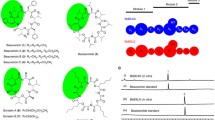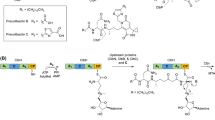Abstract
Peptide natural products constitute a major class of secondary metabolites produced by microorganisms (mostly bacteria and fungi). In the past several decades, researchers have gained extensive knowledge about nonribosomal peptides (NRPs) generated by ribosome-independent systems, namely, NRP synthetases (NRPSs). NRPSs are multifunctional enzymes consisting of semiautonomous domains that form a peptide backbone. Using a thiotemplate mechanism that employs assembly-line logic with multiple modules, NRPSs activate, tether, and modify amino acid building blocks, sequentially elongating the peptide chain before releasing the complete peptide. Adenylation, thiolation, condensation, and thioesterase domains play central roles in these reactions. This chapter focuses on the current understanding of these central domains in NRPS assembly-line enzymology.
Access this chapter
Tax calculation will be finalised at checkout
Purchases are for personal use only
Similar content being viewed by others
References
Winn M, Richardson SM, Campopiano DJ, Micklefield J (2020) Harnessing and engineering amide bond forming ligases for the synthesis of amides. Curr Opin Chem Biol 55:77–85. https://doi.org/10.1016/j.cbpa.2019.12.004
Maruyama C, Hamano Y (2020) tRNA-dependent amide bond-forming enzymes in peptide natural product biosynthesis. Curr Opin Chem Biol 59:164–171. https://doi.org/10.1016/j.cbpa.2020.08.002
Moutiez M, Belin P, Gondry M (2017) Aminoacyl-tRNA-utilizing enzymes in natural product biosynthesis. Chem Rev 117(8):5578–5618. https://doi.org/10.1021/acs.chemrev.6b00523
Stanisic A, Kries H (2019) Adenylation domains in nonribosomal peptide engineering. Chembiochem 20(11):1347–1356. https://doi.org/10.1002/cbic.201800750
Sussmuth RD, Mainz A (2017) Nonribosomal peptide synthesis-principles and prospects. Angew Chem Int Ed Engl 56(14):3770–3821. https://doi.org/10.1002/anie.201609079
Schwarzer D, Finking R, Marahiel MA (2003) Nonribosomal peptides: from genes to products. Nat Prod Rep 20(3):275–287. https://doi.org/10.1039/B111145K
Mootz HD, Schwarzer D, Marahiel MA (2002) Ways of assembling complex natural products on modular nonribosomal peptide synthetases. Chembiochem 3(6):490–504. https://doi.org/10.1002/1439-7633(20020603)3:6<490::AID-CBIC490>3.0.CO;2-N
Gulick AM (2009) Conformational dynamics in the Acyl-CoA synthetases, adenylation domains of non-ribosomal peptide synthetases, and firefly luciferase. ACS Chem Biol 4(10):811–827. https://doi.org/10.1021/cb900156h
Rottig M, Medema MH, Blin K, Weber T, Rausch C, Kohlbacher O (2011) NRPSpredictor2—a web server for predicting NRPS adenylation domain specificity. Nucleic Acids Res 39(Web Server issue):W362–W367. https://doi.org/10.1093/nar/gkr323
Calcott MJ, Owen JG, Ackerley DF (2020) Efficient rational modification of non-ribosomal peptides by adenylation domain substitution. Nat Commun 11(1):4554. https://doi.org/10.1038/s41467-020-18365-0
Reimer JM, Aloise MN, Harrison PM, Schmeing TM (2016) Synthetic cycle of the initiation module of a formylating nonribosomal peptide synthetase. Nature 529(7585):239–242. https://doi.org/10.1038/nature16503
Zhang W, Ntai I, Bolla ML, Malcolmson SJ, Kahne D, Kelleher NL, Walsh CT (2011) Nine enzymes are required for assembly of the pacidamycin group of peptidyl nucleoside antibiotics. J Am Chem Soc 133(14):5240–5243. https://doi.org/10.1021/ja2011109
Steffensky M, Li SM, Heide L (2000) Cloning, overexpression, and purification of novobiocic acid synthetase from streptomyces spheroides NCIMB 11891. J Biol Chem 275(28):21754–21760. https://doi.org/10.1074/jbc.M003066200
Schmutz E, Steffensky M, Schmidt J, Porzel A, Li SM, Heide L (2003) An unusual amide synthetase (CouL) from the coumermycin A1 biosynthetic gene cluster from Streptomyces rishiriensis DSM 40489. Eur J Biochem 270(22):4413–4419. https://doi.org/10.1046/j.1432-1033.2003.03830.x
Maruyama C, Toyoda J, Kato Y, Izumikawa M, Takagi M, Shin-ya K, Katano H, Utagawa T, Hamano Y (2012) A stand-alone adenylation domain forms amide bonds in streptothricin biosynthesis. Nat Chem Biol 8(9):791–797. https://doi.org/10.1038/nchembio.1040
Wolpert M, Gust B, Kammerer B, Heide L (2007) Effects of deletions of mbtH-like genes on clorobiocin biosynthesis in streptomyces coelicolor. Microbiology 153(Pt 5):1413–1423. https://doi.org/10.1099/mic.0.2006/002998-0
Lautru S, Oves-Costales D, Pernodet JL, Challis GL (2007) MbtH-like protein-mediated cross-talk between non-ribosomal peptide antibiotic and siderophore biosynthetic pathways in Streptomyces coelicolor M145. Microbiology 153(Pt 5):1405–1412. https://doi.org/10.1099/mic.0.2006/003145-0
Boll B, Taubitz T, Heide L (2011) Role of MbtH-like proteins in the adenylation of tyrosine during aminocoumarin and vancomycin biosynthesis. J Biol Chem 286(42):36281–36290. https://doi.org/10.1074/jbc.M111.288092
Bryce GF, Brot N (1972) Studies on the enzymatic synthesis of the cyclic trimer of 2,3-dihydroxy-N-benzoyl-L-serine in Escherichia coli. Biochemistry 11(9):1708–1715. https://doi.org/10.1021/bi00759a028
Rusnak F, Faraci WS, Walsh CT (1989) Subcloning, expression, and purification of the enterobactin biosynthetic enzyme 2,3-dihydroxybenzoate-AMP ligase: demonstration of enzyme-bound (2,3-dihydroxybenzoyl)adenylate product. Biochemistry 28(17):6827–6835
McQuade TJ, Shallop AD, Sheoran A, Delproposto JE, Tsodikov OV, Garneau-Tsodikova S (2009) A nonradioactive high-throughput assay for screening and characterization of adenylation domains for nonribosomal peptide combinatorial biosynthesis. Anal Biochem 386(2):244–250. https://doi.org/10.1016/j.ab.2008.12.014
Katano H, Tanaka R, Maruyama C, Hamano Y (2012) Assay of enzymes forming AMP+PPi by the pyrophosphate determination based on the formation of 18-molybdopyrophosphate. Anal Biochem 421(1):308–312. https://doi.org/10.1016/j.ab.2011.10.031
Katano H, Watanabe H, Takakuwa M, Maruyama C, Hamano Y (2013) Colorimetric determination of pyrophosphate anion and its application to adenylation enzyme assay. Anal Sci 29(11):1095–1098
Corpuz JC, Sanlley JO, Burkart MD (2022) Protein-protein interface analysis of the non-ribosomal peptide synthetase peptidyl carrier protein and enzymatic domains. Synth Syst Biotechnol 7(2):677–688. https://doi.org/10.1016/j.synbio.2022.02.006
Haslinger K, Redfield C, Cryle MJ (2015) Structure of the terminal PCP domain of the non-ribosomal peptide synthetase in teicoplanin biosynthesis. Proteins 83(4):711–721. https://doi.org/10.1002/prot.24758
Jaremko MJ, Lee DJ, Opella SJ, Burkart MD (2015) Structure and substrate sequestration in the pyoluteorin type II peptidyl carrier protein PltL. J Am Chem Soc 137(36):11546–11549. https://doi.org/10.1021/jacs.5b04525
Du L, Shen B (1999) Identification and characterization of a type II peptidyl carrier protein from the bleomycin producer Streptomyces verticillus ATCC 15003. Chem Biol 6(8):507–517. https://doi.org/10.1016/S1074-5521(99)80083-0
Yamanaka K, Maruyama C, Takagi H, Hamano Y (2008) Epsilon-poly-L-lysine dispersity is controlled by a highly unusual nonribosomal peptide synthetase. Nat Chem Biol 4(12):766–772. https://doi.org/10.1038/nchembio.125
Yamanaka K, Kito N, Kita A, Imokawa Y, Maruyama C, Utagawa T, Hamano Y (2011) Development of a recombinant epsilon-poly-L-lysine synthetase expression system to perform mutational analysis. J Biosci Bioeng 111(6):646–649. https://doi.org/10.1016/j.jbiosc.2011.01.020
Chen H, Walsh CT (2001) Coumarin formation in novobiocin biosynthesis: beta-hydroxylation of the aminoacyl enzyme tyrosyl-S-NovH by a cytochrome P450 NovI. Chem Biol 8(4):301–312. https://doi.org/10.1016/s1074-5521(01)00009-6
Marahiel MA, Stachelhaus T, Mootz HD (1997) Modular peptide synthetases involved in nonribosomal peptide synthesis. Chem Rev 97(7):2651–2674. https://doi.org/10.1021/cr960029e
Stachelhaus T, Mootz HD, Bergendahl V, Marahiel MA (1998) Peptide bond formation in nonribosomal peptide biosynthesis. Catalytic role of the condensation domain. J Biol Chem 273(35):22773–22781. https://doi.org/10.1074/jbc.273.35.22773
Bergendahl V, Linne U, Marahiel MA (2002) Mutational analysis of the C-domain in nonribosomal peptide synthesis. Eur J Biochem 269(2):620–629. https://doi.org/10.1046/j.0014-2956.2001.02691.x
Roche ED, Walsh CT (2003) Dissection of the EntF condensation domain boundary and active site residues in nonribosomal peptide synthesis. Biochemistry 42(5):1334–1344. https://doi.org/10.1021/bi026867m
Samel SA, Schoenafinger G, Knappe TA, Marahiel MA, Essen LO (2007) Structural and functional insights into a peptide bond-forming bidomain from a nonribosomal peptide synthetase. Structure 15(7):781–792. https://doi.org/10.1016/j.str.2007.05.008
Samel SA, Czodrowski P, Essen LO (2014) Structure of the epimerization domain of tyrocidine synthetase A. Acta Crystallogr D Biol Crystallogr 70(Pt 5):1442–1452. https://doi.org/10.1107/S1399004714004398
Balibar CJ, Vaillancourt FH, Walsh CT (2005) Generation of D amino acid residues in assembly of arthrofactin by dual condensation/epimerization domains. Chem Biol 12(11):1189–1200. https://doi.org/10.1016/j.chembiol.2005.08.010
Dashti Y, Nakou IT, Mullins AJ, Webster G, Jian X, Mahenthiralingam E, Challis GL (2020) Discovery and biosynthesis of bolagladins: unusual lipodepsipeptides from burkholderia gladioli clinical isolates*. Angew Chem Int Ed Engl 59(48):21553–21561. https://doi.org/10.1002/anie.202009110
Royer M, Koebnik R, Marguerettaz M, Barbe V, Robin GP, Brin C, Carrere S, Gomez C, Hugelland M, Voller GH, Noell J, Pieretti I, Rausch S, Verdier V, Poussier S, Rott P, Sussmuth RD, Cociancich S (2013) Genome mining reveals the genus Xanthomonas to be a promising reservoir for new bioactive non-ribosomally synthesized peptides. BMC Genomics 14:658. https://doi.org/10.1186/1471-2164-14-658
Bloudoff K, Schmeing TM (2017) Structural and functional aspects of the nonribosomal peptide synthetase condensation domain superfamily: discovery, dissection and diversity. Biochim Biophys Acta Proteins Proteom 1865(11 Pt B):1587–1604. https://doi.org/10.1016/j.bbapap.2017.05.010
Konz D, Klens A, Schorgendorfer K, Marahiel MA (1997) The bacitracin biosynthesis operon of Bacillus licheniformis ATCC 10716: molecular characterization of three multi-modular peptide synthetases. Chem Biol 4(12):927–937. https://doi.org/10.1016/s1074-5521(97)90301-x
Shen B, Du L, Sanchez C, Edwards DJ, Chen M, Murrell JM (2002) Cloning and characterization of the bleomycin biosynthetic gene cluster from streptomyces verticillus ATCC15003. J Nat Prod 65(3):422–431. https://doi.org/10.1021/np010550q
Vollbrecht L, Steinmetz H, Hofle G, Oberer L, Rihs G, Bovermann G, von Matt P (2002) Argyrins, immunosuppressive cyclic peptides from myxobacteria. II. Structure elucidation and stereochemistry. J Antibiot (Tokyo) 55(8):715–721. https://doi.org/10.7164/antibiotics.55.715
Gehring AM, Mori I, Perry RD, Walsh CT (1998) The nonribosomal peptide synthetase HMWP2 forms a thiazoline ring during biogenesis of yersiniabactin, an iron-chelating virulence factor of Yersinia pestis. Biochemistry 37(33):11637–11650. https://doi.org/10.1021/bi9812571
Vizcaino MI, Crawford JM (2015) The colibactin warhead crosslinks DNA. Nat Chem 7(5):411–417. https://doi.org/10.1038/nchem.2221
Little RF, Hertweck C (2022) Chain release mechanisms in polyketide and non-ribosomal peptide biosynthesis. Nat Prod Rep 39(1):163–205. https://doi.org/10.1039/d1np00035g
Schneider A, Stachelhaus T, Marahiel MA (1998) Targeted alteration of the substrate specificity of peptide synthetases by rational module swapping. Mol Gen Genet 257(3):308–318. https://doi.org/10.1007/s004380050652
Sundlov JA, Shi C, Wilson DJ, Aldrich CC, Gulick AM (2012) Structural and functional investigation of the intermolecular interaction between NRPS adenylation and carrier protein domains. Chem Biol 19(2):188–198. https://doi.org/10.1016/j.chembiol.2011.11.013
Drake EJ, Miller BR, Shi C, Tarrasch JT, Sundlov JA, Allen CL, Skiniotis G, Aldrich CC, Gulick AM (2016) Structures of two distinct conformations of holo-non-ribosomal peptide synthetases. Nature 529(7585):235–238. https://doi.org/10.1038/nature16163
Jaremko MJ, Lee DJ, Patel A, Winslow V, Opella SJ, McCammon JA, Burkart MD (2017) Manipulating protein-protein interactions in nonribosomal peptide synthetase type II peptidyl carrier proteins. Biochemistry 56(40):5269–5273. https://doi.org/10.1021/acs.biochem.7b00884
Corpuz JC, Podust LM, Davis TD, Jaremko MJ, Burkart MD (2020) Dynamic visualization of type II peptidyl carrier protein recognition in pyoluteorin biosynthesis. RSC Chem Biol 1(1):8–12. https://doi.org/10.1039/c9cb00015a
Miyanaga A, Kurihara S, Chisuga T, Kudo F, Eguchi T (2020) Structural characterization of complex of adenylation domain and carrier protein by using pantetheine cross-linking probe. ACS Chem Biol 15(7):1808–1812. https://doi.org/10.1021/acschembio.0c00403
Tanovic A, Samel SA, Essen LO, Marahiel MA (2008) Crystal structure of the termination module of a nonribosomal peptide synthetase. Science 321(5889):659–663. https://doi.org/10.1126/science.1159850
Reimer JM, Eivaskhani M, Harb I, Guarne A, Weigt M, Schmeing TM (2019) Structures of a dimodular nonribosomal peptide synthetase reveal conformational flexibility. Science 366(6466). https://doi.org/10.1126/science.aaw4388
Author information
Authors and Affiliations
Corresponding author
Editor information
Editors and Affiliations
Rights and permissions
Copyright information
© 2023 The Author(s), under exclusive license to Springer Science+Business Media, LLC, part of Springer Nature
About this protocol
Cite this protocol
Maruyama, C., Hamano, Y. (2023). The Assembly-Line Enzymology of Nonribosomal Peptide Biosynthesis. In: Burkart, M., Ishikawa, F. (eds) Non-Ribosomal Peptide Biosynthesis and Engineering. Methods in Molecular Biology, vol 2670. Humana, New York, NY. https://doi.org/10.1007/978-1-0716-3214-7_1
Download citation
DOI: https://doi.org/10.1007/978-1-0716-3214-7_1
Published:
Publisher Name: Humana, New York, NY
Print ISBN: 978-1-0716-3213-0
Online ISBN: 978-1-0716-3214-7
eBook Packages: Springer Protocols




